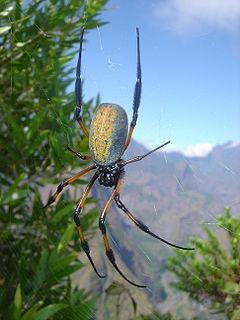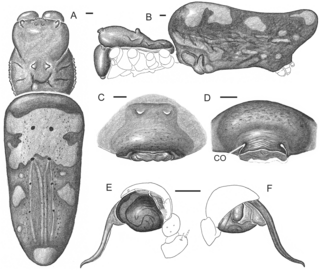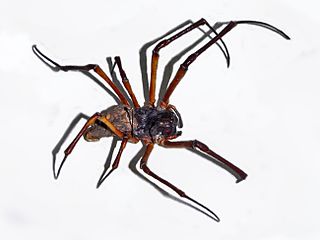
Spider silk is a protein fibre spun by spiders. Spiders use their silk to make webs or other structures, which function as sticky nets to catch other animals, or as nests or cocoons to protect their offspring, or to wrap up prey. They can also use their silk to suspend themselves, to float through the air, or to glide away from predators. Most spiders vary the thickness and stickiness of their silk for different uses.

Orb-weaver spiders are members of the spider family Araneidae. They are the most common group of builders of spiral wheel-shaped webs often found in gardens, fields and forest. "Orb" can in English mean "circular", hence the English name of the group. Araneids have eight similar eyes, hairy or spiny legs, and no stridulating organs.

Nephila is a genus of araneomorph spiders noted for the impressive webs they weave. Nephila consists of numerous species found in warmer regions around the world. They are commonly called golden silk orb-weavers, golden orb-weavers, giant wood spiders, or banana spiders.
Banana spider may refer to:

Trichonephila inaurata,, commonly known as the red-legged golden orb-weaver spider or red-legged nephila, is a species of orb-weaver spider of the genus Trichonephila. It is native to southern and East Africa, as well as several islands of the western Indian Ocean.

Trichonephila clavata, also known as the Jorō spider, is a member of the golden orb-web spider genus. The spider can be found throughout Japan, in Korea, Taiwan, China, and more recently, northeast Georgia in North America. Due to the large size as well as the bright, unique colors of the female Trichonephila, the spider is well-favored in Japan.

Trichonephila clavipes, commonly known as the golden silk orb-weaver, golden silk spider, or banana spider, is an orb-weaving spider species which inhabits forests and wooded areas ranging from the southern US to Argentina. In fact, it is the only species of the genus Trichonephila indigenous to continental North and South America. Known for the golden color of their silk, the large size of their females, and their distinctive red-brown and yellow coloring, T. clavipes construct large, asymmetrical circular webs attached to trees and low shrubs in woods to catch small- and medium-size flying prey, mostly insects. They are excellent web-builders, producing and utilizing seven different types of silk, and they subdue their prey by injecting them with venom, as opposed to related species which immobilize their prey by wrapping them in silk first. They are not known to be aggressive towards humans, only biting out of self-defense if touched, and their relatively harmless venom has a low toxicity, posing little health concern to healthy human adults. Due to their prevalence in forests, T. clavipes may be encountered by hikers.

Nephilinae is a spider subfamily of the family Araneidae with seven genera. The various genera in Nephilinae were formerly grouped in the family Nephilidae, and before that in the Tetragnathidae and in the Araneidae. All nephiline genera partially renew their webs. Spiders in the subfamily Nephilinae are commonly referred to as golden orb-weavers.

Trichonephila edulis is a species of large spider of the family Araneidae, formerly placed in the genus Nephila. It is referred to the common name Australian golden orb weaver. It is found in Australia, in both tropical and temperate regions, and in parts of New Guinea and New Caledonia.

Nephila pilipes is a species of golden orb-web spider. It resides all over countries in East and Southeast Asia as well as Oceania. It is commonly found in primary and secondary forests and gardens. Females are large and grow to a body size of 30–50 mm, with males growing to 5–6 mm. It is the second largest of the orb-weaving spiders apart from the recently discovered Nephila komaci. The first, second, and fourth pairs of legs of juvenile females have dense hairy brushes, but these brushes disappear as the spider matures.
Nephilengys is a genus of tropical spiders of the family Araneidae, consisting of two currently described species. The genus Nephilingis has been split off from this genus. Both genera have been called hermit spiders from the habit staying in their retreats during the day; the name eunuch spiders has been used for Nephilengys alone. Males may sever parts of their palpal bulbs after copulation.

Trichonephila plumipes is a species of spider found in Australia, Indonesia and some Pacific Islands, which exhibits extreme sexual dimorphism through its sexual cannibalism behavior. It is sometimes called the tiger spider due to its markings which look similar to a tiger. This species was formerly called Nephila plumipes. As with other spiders from the genus Nephila, these spiders have a distinct golden web.

Nephila komaci is a species of golden orb-web spider. It is the largest web-spinning spider known. A few specimens have been found in South Africa and Madagascar.

Mongolarachne is an extinct genus of spiders placed in the monogeneric family Mongolarachnidae. The genus contains only one species, Mongolarachne jurassica, described in 2013, which is presently the largest fossilized spider on record. The type species was originally described as Nephila jurassica and placed in the living genus Nephila which contains the golden silk orb-weavers.
Senegalensis and its alternative form senegalense are Latin adjectival suffixes meaning pertaining to, or originating in Senegal. They are often used as the second word of a binomial name.
Nephila antipodiana, also known as the batik golden web spider, is a species of golden orb-web spider discovered in 1841 by Charles Athanase Walckenaer. The species is found throughout Australia, China, Indonesia, the Philippines, and Thailand. The spider's silk contains a pyrrolidine alkaloid which serves as a chemical repellent to keep ants away from the spider's web.

Nephila sumptuosa, the red-legged golden orb-web spider, is a species of golden orb-web spider.

Stegodyphus dumicola, commonly known as the African social spider, is a species of spider of the family Eresidae or the velvet spider family. It is native to Central and southern Africa. This spider is one of three Stegodyphus spiders that lives a social lifestyle. This spider has been studied living in large natal colonies in large, unkempt webs. Each colony is composed mainly of females, where a minority act as reproducers, and a majority remain females and take care of the young. Males live a shorter lifespan and will largely remain in the natal nest throughout its life. Females are known for extreme allomaternal care, since all females, even unmated virgin females will take care of the young until they are eventually consumed by the brood.

Trichonephila is a genus of orb-weaver spiders that was first described by Friedrich Dahl in 1911, as a subgenus of Nephila. Trichonephila was elevated to the level of genus by Kuntner et al in 2019.















